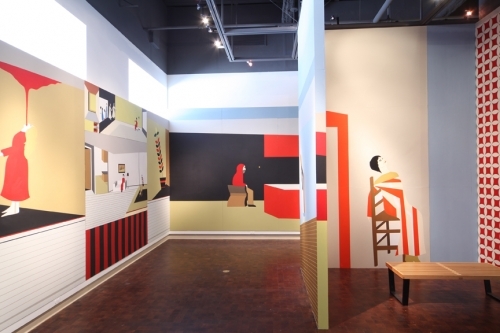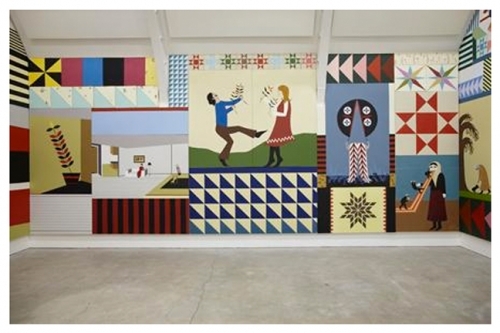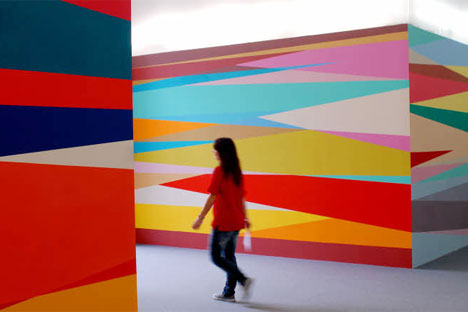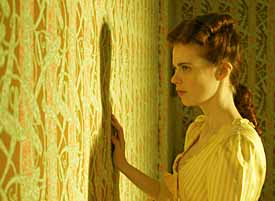In my last post, I discussed Italian author Italo Calvino’s ability to use only words to render images of fantastical cities, far away galaxies and ancient landscapes. His words transcend themselves, and in effect, work themselves out of a job. Now I wonder, in the case of visual art, does the opposite occur? When we look at a piece of artwork, do we automatically find the words to replace the image? Is it possible to read a visual artwork when absolutely no words are visibly present? Or, if we think of it conversely, can literature exist in a purely visual form?
First of all, let’s get the term illustration out of the way. There are of course extensions of illustration in nearly every facet of visual art. However, for the purpose of this post I want to disregard illustration in the way it regularly functions as ancillary or complementary imagery in order to further explain what the author should have already made clear. Children’s books and comics generally fit into this category because their pictures visually reinforce what has already happened in the given text. Rather, I want to focus on artworks that are the story, images that conjure the words of a stylistic narrative complex enough to be a novel, pictures that move and unfold at the viewer’s discretion. Even more specifically, I am referring to a set of visuals that requires the viewer to author their own adventure through time and space.
Though a piece of fiction writing isn’t an obvious place to begin a discussion on how a purely visual literature might come to be, I find Charlotte Perkins Gilman’s 1892 “The Yellow Wallpaper” to strangely exemplify how a visual literature might work in the imagination. (Never mind whether or not that imagination belongs to a psychologically sound individual.) This short story is a first-person account of a young mother’s mental deterioration and is based on Gilman’s own experiences with post-partum depression. Like Gilman, the unnamed leading lady has been advised, based on medical theories of the time, to abstain from any and all physical activity and intellectual stimulation. Closely monitored by her husband, she may not read, write, or talk with anyone. To carry out this treatment, the woman’s husband takes her to a country house where he keeps her locked up in the attic, a former nursery decorated with hideous yellow wallpaper. The woman, so thirsty for words, sentences, whole paragraphs of conversation, goes to the depths of insanity to find them by reading in the images in the yellow wallpaper a horrifying tale of wrongful imprisonment. She discovers that a woman living in the wallpaper shakes the bars of the paper’s pattern as she tries, unsuccessfully, to climb through them. This woman within the paper design, embodying the heroine’s own tale of emotional and intellectual confinement, reconfigures herself time and again, continuously begging her reader—the heroine trapped in the attic—to use the words that might orchestrate her release.

Installation view of "We They, We They," 2010, at the Museum of Craft and Folk Art in San Francisco, CA. Image courtesy Kavi Gupta Gallery, Chicago.

Installation view of "We They, We They" at Ikon Gallery in Birmingham, England. Image courtesy Kavi Gupta Gallery, Chicago.
Similarly, the women seen in San Franciscan artist Clare E. Rojas’ wall paintings beg to be read. Known for her folk-inspired practice, Rojas designs could-be-called visual literature that challenges the stereotypical representations of women (and infrequently men) through a homespun aesthetic of flat patterns and geometric shapes. She uses a wide range of media, including painting, prints, installation and video, most often creating series of domestic and pastoral images injected with a combinatory color palette that borrows from both 1960s Op art and southwestern textiles. Indeed, Rojas’ pictorial style draws from a host of traditions, including the DIY aesthetic of her Bay Area Mission School peers, Latino and Eastern European folk art, Native American craft, outsider art and abstract painting. In some of her larger installations, she incorporates stripes, bands and large swaths of color that act as a conveyor-belt path that physically moves the viewer along, keeping him or her reading, progressing, formulating an epic tale. And like the lady within the yellow wallpaper’s pattern, Rojas’ ladies animate when the viewer sets forward with language to delineate ticking time and scene changes.

Installation view (detail) of "Give Me Shelter," 2007 by Odili Donald Odita at the 52nd Venice Biennale. Image by Eric Vandeville of Le Figaro Magazine.
In terms of thinking about a purely visual literature, walls, floors and three-dimensional space seems important. The ability to travel through the artwork allows the viewer to compose both linear and cyclical time, thusly organizing meaning and points of reference throughout the narrative just as a novelist would. Perhaps this kind of free movement makes it possible to read abstraction as well. The vibrant murals and installations of artists like Sol Lewitt, Odili Donald Odita and Jim Lambie stretch through vast spaces, imploring the viewer to keep going and going. Plotted patterns and colors twist, turn and combine into scenarios brimming with surprise, romance, comedy, drama, nostalgia and more. Odita even encourages his audiences to read into the histories and inferences of his color palette. Looking closely, reading between the shapes and lines the viewer could wind up on a beach in Johannesburg, watching television in a Tokyo bar circa 1976, fighting in the United States civil war, chasing rainbows across Ireland….
*Because one must give credit where credit is due, “Painting with Words, Writing with Pictures” originates as the title of literary critic Franco Ricci’s brilliant book exploring visual description and perception in Italo Calvino’s stories.




